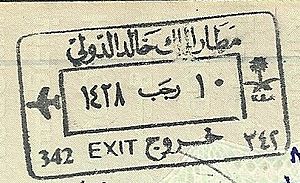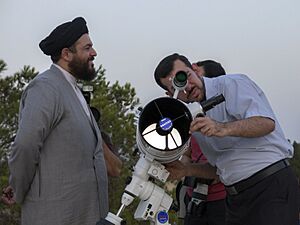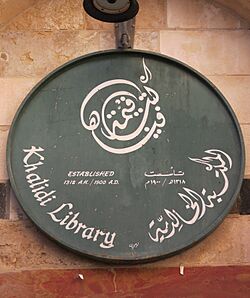Islamic calendar facts for kids
Quick facts for kids Today |
|
|---|---|
| Saturday | |
| Gregorian calendar | December 20, 2025 |
| Islamic calendar | 29 Jumada al-thani, 1447 AH |
| Hebrew calendar | 30 Kislev, AM 5786 |
| Coptic calendar | Koiak 11, 1742 AM |
| Solar Hijri calendar | 29 Azar, 1404 SH |
| Bengali calendar | Poush 7 BS |
| Julian calendar | 7 December 2025
[] |
The Hijri calendar (Arabic: ٱلتَّقْوِيم ٱلْهِجْرِيّ, romanized: al-taqwīm al-hijrī), also known as the Islamic calendar, is a calendar based on the cycles of the Moon. A year in this calendar has 12 months and lasts for 354 or 355 days.
This calendar is very important to Muslims because it is used to set the dates for religious holidays and events, such as the month of fasting called Ramadan and the yearly pilgrimage to Mecca called the Hajj.
Most countries where Islam is the main religion use the Gregorian calendar for daily life. However, they use the Hijri calendar for religious matters.
The calendar begins in the year 622 CE (Common Era). This was the year that the Prophet Muhammad and his followers moved from the city of Mecca to Medina. This important journey is called the Hijrah. Years in the Islamic calendar are marked as AH, which stands for the Latin words Anno Hegirae, meaning "in the year of the Hijrah."
The current Islamic year is 1447 AH. It began on June 26, 2025, and will end on approximately June 15, 2026.
Contents
The Story of the Islamic Calendar
Early Arabian Calendars
Before Islam, people in Arabia used various calendars. Many of these were lunisolar, meaning they followed the Moon but also added an extra month every few years to stay in sync with the seasons. This was helpful for farming and trade.
A Calendar Based Only on the Moon
The Qur'an, the holy book of Islam, established a calendar with exactly twelve months, based only on the Moon's cycles. The practice of adding an extra month (known as Nasī' ) was stopped.
Because the Islamic calendar is a purely lunar calendar, it is about 11 days shorter than the solar (Gregorian) calendar. This means that Islamic holidays do not stay in the same season. For example, Ramadan can be in the summer one year, but over time it will move into spring, winter, and autumn. It takes about 33 years for the Islamic calendar to cycle through all the seasons.
The Start of a New Era
In the early years of Islam, the years were not numbered. Instead, they were named after a major event that happened in them, like "the year of permission."
Around the year 638 CE, the Caliph Umar, a leader of the Muslim community, realized that they needed a better system. After talking with his advisors, he decided that the calendar should start from the year of the Hijrah. This event was chosen because it marked the beginning of the first Muslim community (ummah). The calendar was named the Hijri calendar in honor of this journey.
Days of the Week
In the Islamic tradition, a new day begins at sunset, not at midnight. The names for the days of the week are based on their number. For example, al-Aḥad means "the First" and al-Ithnayn means "the Second."
The sixth day, al-Jumʿah, means "the Gathering." On this day, Muslims gather for a special prayer at the mosque around noon. Friday is the main day of rest in many Muslim countries.
| No. | Name | Arabic | Meaning | English equivalent |
|---|---|---|---|---|
| 1 | al-ʾAḥad | ٱلْأَحَد | the One | Saturday night and Sunday daytime |
| 2 | al-Ithnayn | الاِثْنَيْن | the Second | Sunday night and Monday daytime |
| 3 | ath-Thulāthāʾ | ٱلثُّلَاثَاء | the Third | Monday night and Tuesday daytime |
| 4 | al-ʾArbiʿāʾ | ٱلْأَرْبِعَاء | the Fourth | Tuesday night and Wednesday daytime |
| 5 | al-Khamīs | ٱلْخَمِيس | the Fifth | Wednesday night and Thursday daytime |
| 6 | al-Jumʿah | ٱلْجُمْعَة | the Gathering | Thursday night and Friday daytime |
| 7 | as-Sabt | ٱلسَّبْت | the Rest | Friday night and Saturday daytime |
Months of the Year
An Islamic month begins when the new crescent moon (called a hilal) is first seen in the sky after sunset. Because of this, a month can be either 29 or 30 days long.
Four of the months are considered sacred, which means that fighting was traditionally forbidden during them. These are Rajab, Dhū al-Qa'dah, Dhu al-Ḥijjah, and Muḥarram.
| No. | Name | Arabic | Meaning | Note |
|---|---|---|---|---|
| 1 | al-Muḥarram | ٱلْمُحَرَّم | forbidden | A sacred month when fighting is forbidden. |
| 2 | Ṣafar | صَفَر | void | Named because Arab homes were empty as people gathered food. |
| 3 | Rabīʿ al-ʾAwwal | رَبِيع ٱلْأَوَّل | the first spring | The month when the Prophet Muhammad was born. |
| 4 | Rabīʿ ath-Thānī | رَبِيع ٱلثَّانِي | the second spring | |
| 5 | Jumādā al-ʾŪlā | جُمَادَىٰ ٱلْأُولَىٰ | the first of parched land | A dry month in pre-Islamic times. |
| 6 | Jumādā ath-Thāniyah | جُمَادَىٰ ٱلثَّانِيَة | the second of parched land | |
| 7 | Rajab | رَجَب | respect, honour | The second sacred month when fighting is forbidden. |
| 8 | Shaʿbān | شَعْبَان | scattered | A time when Arab tribes would disperse to find water. |
| 9 | Ramaḍān | رَمَضَان | burning heat | The most important month. Muslims fast from dawn until sunset. |
| 10 | Shawwāl | شَوَّال | raised | The first day is Eid al-Fitr, the festival that marks the end of Ramadan. |
| 11 | Ḏū al-Qaʿdah | ذُو ٱلْقَعْدَة | the one of truce | A sacred month when war is banned. |
| 12 | Ḏū al-Ḥijjah | ذُو ٱلْحِجَّة | the one of pilgrimage | In this month, Muslims perform the Hajj pilgrimage to Mecca. It includes the festival of Eid al-Adha. |
How a New Month Begins
Sighting the Moon
The traditional way to start a new month is by physically looking for the crescent moon (the hilal) in the sky just after sunset on the 29th day of the month.
- If the moon is seen, the new month begins at sunset.
- If the moon is not seen (because of clouds or its position), the current month lasts for 30 days, and the new month begins the following day.
This method relies on human observation, and different people in different parts of the world might see the moon on different days. This is why some Muslim countries may start holidays like Ramadan or Eid on a different day than others.
Using Calculations
Today, many countries and organizations use astronomical calculations to predict when the new moon will be visible. This allows them to create calendars in advance and helps unify the start dates of months.
For example, countries like Saudi Arabia use a calendar called the Umm al-Qura calendar, which is based on calculations. It determines the start of the month based on when the new moon is expected to be visible in Mecca. However, many communities still prefer the traditional method of sighting the moon with their own eyes.
Important Islamic Dates
Here are some of the most important dates in the Hijri calendar:
- 1 Muharram: The Islamic New Year.
- 10 Muharram: The Day of Ashura, a day of remembrance.
- 12 Rabi al-Awwal: Mawlid, the birthday of the Prophet Muhammad for Sunni Muslims.
- 17 Rabi al-Awwal: Mawlid for Shia Muslims.
- 27 Rajab: Isra and Mi'raj, the night journey and ascension of the Prophet Muhammad.
- 1 Ramadan: The first day of fasting.
- Last ten days of Ramadan: Includes Laylat al-Qadr, the "Night of Power," when the first verses of the Qur'an were revealed.
- 1 Shawwal: Eid ul-Fitr, the festival celebrating the end of Ramadan.
- 8–13 Dhu al-Hijjah: The time for the Hajj pilgrimage to Mecca.
- 10 Dhu al-Hijjah: Eid al-Adha, the "Festival of the Sacrifice."
How the Calendar is Used Today
Today, the Islamic calendar is used mainly for religious purposes. It helps Muslims know when to fast, celebrate festivals, and perform pilgrimages.
For most other things, like business, school, and daily life, most Muslim countries use the Gregorian calendar. Some countries, like Saudi Arabia, use the Hijri calendar for official government dating of documents. It is common to see both the Hijri and Gregorian dates written on documents and signs in the Muslim world.
See also
 In Spanish: Calendario musulmán para niños
In Spanish: Calendario musulmán para niños
- Islamic New Year
- List of observances set by the Islamic calendar
- Pre-Islamic Arabian calendar
- Solar Hijri calendar
- Timeline of Islamic history




